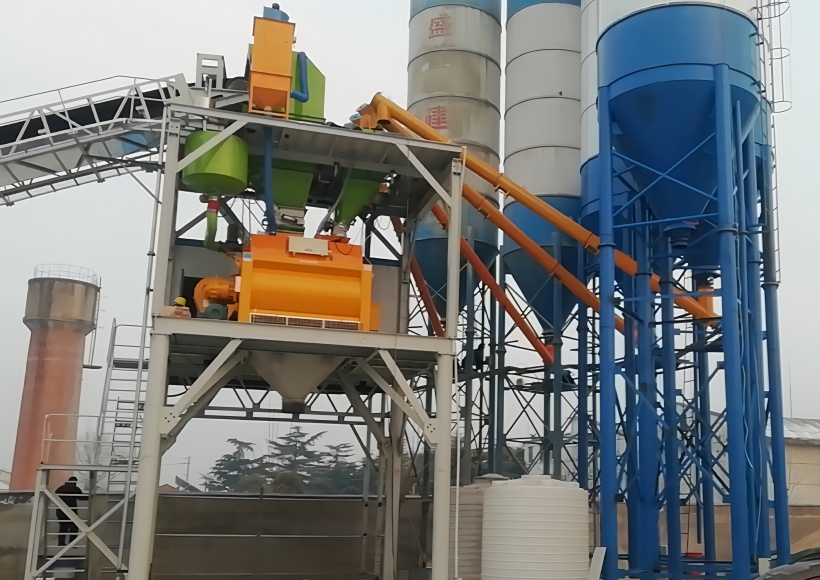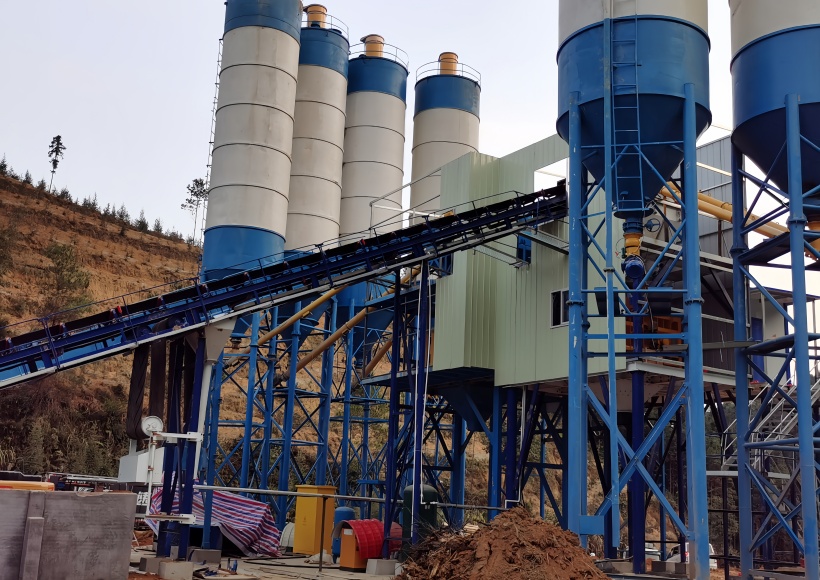In large-scale concrete production projects, the selection of batching plants directly impacts project quality, production efficiency, and return on investment. For an annual output of 300,000 cubic meters of concrete, the HZS120 and HZS180 are the most common choices. This article provides a comprehensive comparison of these two models in terms of technical parameters, production capacity, investment costs, and operational benefits to support informed decision-making.
I. Core Parameter Comparison: HZS120 vs. HZS180
1.1 Key Technical Differences
The HZS120 and HZS180, as primary models for concrete production, exhibit significant technical differences:
- Theoretical Productivity:
- HZS120: 120 m³/h
- HZS180: 180 m³/h
- Mixer Configuration:
- HZS120: JS2000 twin-shaft forced mixer, discharge capacity 2 m³
- HZS180: JS3000 twin-shaft forced mixer, discharge capacity 3 m³
- Aggregate Storage Capacity:
- HZS120: 4 × 20 m³
- HZS180: 4 × 25 m³
- Powder Storage Configuration:
- HZS120: 4 × 100 t
- HZS180: 4 × 150 t
- Installed Power:
- HZS120: ~230 kW
- HZS180: ~280 kW
1.2 Actual Production Capacity Analysis
The gap between theoretical and actual capacity is a critical consideration:
- HZS120 Actual Capacity:
- Industry Standard: 80–90 m³/h
- Daily Capacity (10 hours): 800–900 m³
- Annual Capacity (300 days): 240,000–270,000 m³
- HZS180 Actual Capacity:
- Industry Standard: 120–130 m³/h
- Daily Capacity (10 hours): 1,200–1,300 m³
- Annual Capacity (300 days): 360,000–390,000 m³
Capacity Comparison Table:
Parameter | HZS120 | HZS180 |
Theoretical Capacity(m³/h) | 120 | 180 |
Actual Capacity (m³/h) | 80-90 | 120-130 |
Daily Capacity(m³/10h) | 800-900 | 1200-1300 |
Annual Capacity (m³/300d) | 24-27Ten thousand | 36-39Ten thousand |
II. Configuration Comparison for 300,000 m³ Annual Projects
2.1 Single HZS180 Solution Analysis
Feasibility of using one HZS180 plant for 300,000 m³ annual output:
- Capacity Evaluation:
- Theoretical Maximum Annual Output: 180 × 10 × 300 = 540,000 m³
- Achievable Annual Output: ~350,000 m³ (at 85% utilization)
- Advantages:
- Smaller footprint, suitable for space-constrained sites
- Lower initial investment (~30–50% less than dual HZS120)
- Fewer operational staff and simpler management
- Risks:
- Equipment failure halts entire production
- High pressure during peak demand periods
- Faster mixer wear and higher maintenance costs
2.2 Dual HZS120 Solution Analysis
Using two HZS120 plants for 300,000 m³ annual output:
- Capacity Evaluation:
- Single Plant Annual Output: ~240,000 m³
- Dual Plant Annual Output: ~480,000 m³
- Flexible operation: one plant can be shut down to save energy
- Advantages:
- High production flexibility to handle demand fluctuations
- Simpler spare parts management
- Maintenance possible without halting production
- Disadvantages:
- Higher initial investment (~30–50% more than single HZS180)
- Larger footprint: requires ~8,000 m²
- More operational staff and higher management complexity
2.3 Hybrid Configuration
Innovative solution combining both models:
- 1 × HZS180 + 1 × HZS120 Combination:
- Base capacity from HZS180
- HZS120 activated during peak demand
- Annual output exceeds 500,000 m³
- Higher investment than single or dual configurations
- Advantages:
- Maximum flexibility in capacity management
- Higher return on investment
- Scalable for future expansion

III. Investment and Operational Cost Comparison
3.1 Initial Investment Analysis
- Equipment Purchase Cost:
- HZS120: ~800,000–1,000,000 RMB/unit
- HZS180: ~900,000–1,200,000 RMB/unit
- Ancillary Equipment:
- Dual HZS120 requires two loading shovels
- Single HZS180 requires larger but fewer ancillary devices
- Civil Engineering Costs:
- Dual HZS120: ~8,000 m² site
- Single HZS180: ~6,000 m² site
3.2 Operational Cost Comparison
- Energy Consumption:
- HZS120: ~230 kW/unit
- HZS180: ~280 kW/unit
- Dual HZS120 consumes less energy when one unit operates
- Labor Costs:
- Dual HZS120: 2 shifts of operators
- Single HZS180: 1.5 shifts of operators
- Maintenance Costs:
- HZS180 requires more frequent mixer maintenance
- Dual HZS120 allows alternating maintenance without production loss
3.3 Return on Investment Analysis
Based on 300,000 m³ annual output:
- Assumptions:
- Average concrete price: 300 RMB/m³
- Direct cost: 200 RMB/m³
- Annual overhead: 2 million RMB (dual HZS120), 1.5 million RMB (single HZS180)
- Economic Comparison:
- Dual HZS120 annual gross profit: (300–200) × 300,000 – 2 million = 28 million RMB
- Single HZS180 annual gross profit: (300–200) × 300,000 – 1.5 million = 28.5 million RMB
IV. Key Considerations for Project Suitability
4.1 Concrete Demand Characteristics
- Demand Fluctuations:
- Stable demand: suitable for single HZS180 (lower operational risk)
- Volatile demand: suitable for dual HZS120
- Concrete Varieties:
- Multiple grades: dual HZS120 allows dedicated production lines
- Single grade: suitable for high-capacity single line
4.2 Site Constraints
- Land Area:
- Dual HZS120: ≥8,000 m²
- Single HZS180: ~6,000 m²
- Topography:
- Narrow sites: linear layout for dual HZS120
- Square sites: centralized layout for HZS180
4.3 Environmental Requirements
- Noise Control:
- Single HZS180: easier noise management at one point
- Dual HZS120: requires multi-point noise reduction
- Dust Management:
- Modern HZS180: often fully enclosed tower design
- HZS120: typically requires additional dust control measures

V. Decision Recommendations and Best Practices
5.1 Selection Guidelines by Scenario
- Dual HZS120 Recommended For:
- Projects with >±20% demand fluctuations
- Production of multiple special concrete types
- Critical projects requiring high reliability
- Potential future expansion beyond 500,000 m³
- Single HZS180 Recommended For:
- Stable-demand municipal or real estate projects
- Urban projects with space constraints
- Budget-conscious projects
- Projects with lean operational teams
5.2 Case Studies
- Case 1: Cross-Sea Bridge Project (Dual HZS120)
- Features: Tight schedule, high quality requirements, volatile demand
- Configuration: 2 × HZS120, mutually backup
- Results: <0.5% downtime over three years
- Key Advantage: 50% capacity maintained during maintenance
- Case 2: Industrial Park Project (Single HZS180)
- Features: Stable demand, limited space
- Configuration: 1 × HZS180 + backup small mixer
- Key Advantage: 30% land savings, lower management costs
5.3 Future Expansion Considerations
- Dual HZS120 Expansion Path:
- Add a third HZS120 to reach 600,000 m³ capacity
- Upgrade control system for smart scheduling
- HZS180 Expansion Path:
- Add HZS120 for hybrid production line
- Upgrade mixer to JS4000 for higher single-line capacity
Conclusion: Scientific Selection Maximizes Value
For projects with an annual production capacity of 300,000 cubic meters of concrete, the HZS120 and HZS180 each have their advantages. The dual-unit HZS120 configuration offers greater flexibility and reliability, meeting evolving needs and high-quality requirements. The single-unit HZS180, on the other hand, saves investment and space and is suitable for stable, standardized projects. Decision-makers should comprehensively consider their needs, budget, and site conditions to select the optimal configuration.
As concrete batching plant technology evolves towards smarter and more environmentally friendly technologies, future choices should prioritize digitalization and environmental performance. Regardless of the solution chosen, partnering with a supplier with a strong after-sales network ensures long-term, stable operation. Tongxin Machinery recommends that a scientific selection approach lays the foundation for sustainable competitiveness in concrete production.